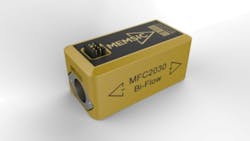Mouser signs global distribution agreement with MEMSIC
Mouser Electronics Inc. has announced a global distribution agreement with MEMSIC Inc. Through the new agreement, Mouser will distribute MEMSIC MEMS sensors to customers worldwide.
The MEMSIC product line enables mobility and the Internet of Things by combining the essential elements for engineers’ application needs, including solutions for drone, mobile, wearable, industrial, medical, and smart-parking applications. The MEMSIC product line at Mouser Electronics features a variety of sensor products, including magnetic and e-compass products, accelerometers, 6-DOF and 9-DOF inertial measurement units (IMUs) and orientation sensors, and gas flow modules.
For example, the MEMSIC MMC5883MA anisotropic magneto resistive (AMR)-based three-axis magnetic sensor provides high accuracy, low noise, and low power consumption. The sensor provides 16-bit operation over a ±8 Gauss operating range and features linearity of ±0.2% full scale range (FSR), hysteresis of 0.2% FSR, and repeatability of 0.2% FSR on each of its three axes. It exhibits current consumption of 20 µA at a data rate of seven samples per second and noise level of 0.4 mGauss total RMS noise. Combining this performance in an industry-standard small LGA package the sensor addresses the ever-increasing demands of industrial and drone applications.
In addition, the low-cost MXC6255XC/U DTOS accelerometers are two-axis motion and orientation sensors, based on MEMSIC’s MEMS thermal technology. The DTOS accelerometers allow designers to integrate key user interfaces, such as programmable “shake to change” menu navigation, TV/music channel selection, and vertical/horizontal picture orientation. The devices can also provide some basic game play control, fall-over detection in irons and other appliances, and other applications in mobile devices, toys, and consumer electronics.
About the Author

Rick Nelson
Contributing Editor
Rick is currently Contributing Technical Editor. He was Executive Editor for EE in 2011-2018. Previously he served on several publications, including EDN and Vision Systems Design, and has received awards for signed editorials from the American Society of Business Publication Editors. He began as a design engineer at General Electric and Litton Industries and earned a BSEE degree from Penn State.

